Amit Roy
Transformers Can Learn Connectivity in Some Graphs but Not Others
Sep 26, 2025Abstract:Reasoning capability is essential to ensure the factual correctness of the responses of transformer-based Large Language Models (LLMs), and robust reasoning about transitive relations is instrumental in many settings, such as causal inference. Hence, it is essential to investigate the capability of transformers in the task of inferring transitive relations (e.g., knowing A causes B and B causes C, then A causes C). The task of inferring transitive relations is equivalent to the task of connectivity in directed graphs (e.g., knowing there is a path from A to B, and there is a path from B to C, then there is a path from A to C). Past research focused on whether transformers can learn to infer transitivity from in-context examples provided in the input prompt. However, transformers' capability to infer transitive relations from training examples and how scaling affects the ability is unexplored. In this study, we seek to answer this question by generating directed graphs to train transformer models of varying sizes and evaluate their ability to infer transitive relations for various graph sizes. Our findings suggest that transformers are capable of learning connectivity on "grid-like'' directed graphs where each node can be embedded in a low-dimensional subspace, and connectivity is easily inferable from the embeddings of the nodes. We find that the dimensionality of the underlying grid graph is a strong predictor of transformers' ability to learn the connectivity task, where higher-dimensional grid graphs pose a greater challenge than low-dimensional grid graphs. In addition, we observe that increasing the model scale leads to increasingly better generalization to infer connectivity over grid graphs. However, if the graph is not a grid graph and contains many disconnected components, transformers struggle to learn the connectivity task, especially when the number of components is large.
GAD-NR: Graph Anomaly Detection via Neighborhood Reconstruction
Jun 07, 2023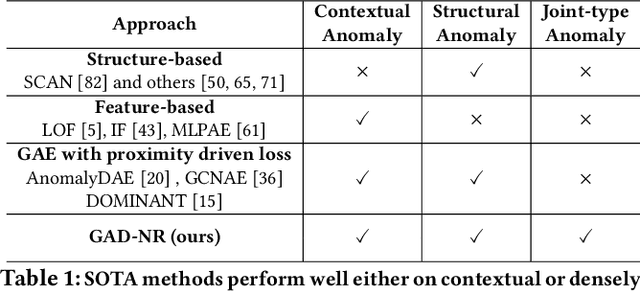


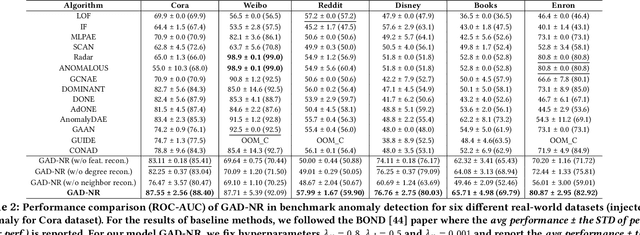
Abstract:Graph Anomaly Detection (GAD) is a technique used to identify abnormal nodes within graphs, finding applications in network security, fraud detection, social media spam detection, and various other domains. A common method for GAD is Graph Auto-Encoders (GAEs), which encode graph data into node representations and identify anomalies by assessing the reconstruction quality of the graphs based on these representations. However, existing GAE models are primarily optimized for direct link reconstruction, resulting in nodes connected in the graph being clustered in the latent space. As a result, they excel at detecting cluster-type structural anomalies but struggle with more complex structural anomalies that do not conform to clusters. To address this limitation, we propose a novel solution called GAD-NR, a new variant of GAE that incorporates neighborhood reconstruction for graph anomaly detection. GAD-NR aims to reconstruct the entire neighborhood of a node, encompassing the local structure, self-attributes, and neighbor attributes, based on the corresponding node representation. By comparing the neighborhood reconstruction loss between anomalous nodes and normal nodes, GAD-NR can effectively detect any anomalies. Extensive experimentation conducted on six real-world datasets validates the effectiveness of GAD-NR, showcasing significant improvements (by up to 30% in AUC) over state-of-the-art competitors. The source code for GAD-NR is openly available. Importantly, the comparative analysis reveals that the existing methods perform well only in detecting one or two types of anomalies out of the three types studied. In contrast, GAD-NR excels at detecting all three types of anomalies across the datasets, demonstrating its comprehensive anomaly detection capabilities.
Unified Spatio-Temporal Modeling for Traffic Forecasting using Graph Neural Network
Apr 28, 2021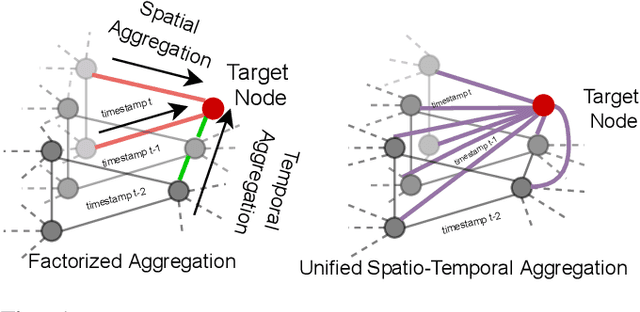
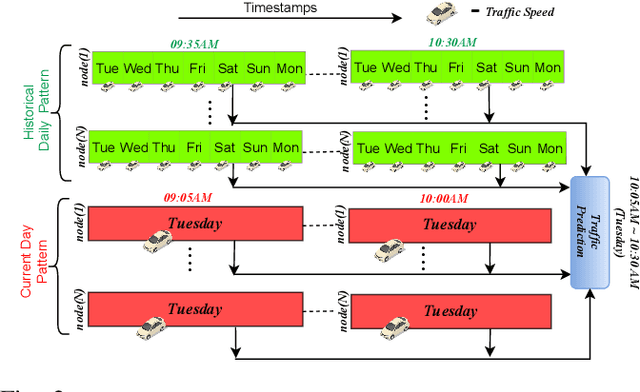


Abstract:Research in deep learning models to forecast traffic intensities has gained great attention in recent years due to their capability to capture the complex spatio-temporal relationships within the traffic data. However, most state-of-the-art approaches have designed spatial-only (e.g. Graph Neural Networks) and temporal-only (e.g. Recurrent Neural Networks) modules to separately extract spatial and temporal features. However, we argue that it is less effective to extract the complex spatio-temporal relationship with such factorized modules. Besides, most existing works predict the traffic intensity of a particular time interval only based on the traffic data of the previous one hour of that day. And thereby ignores the repetitive daily/weekly pattern that may exist in the last hour of data. Therefore, we propose a Unified Spatio-Temporal Graph Convolution Network (USTGCN) for traffic forecasting that performs both spatial and temporal aggregation through direct information propagation across different timestamp nodes with the help of spectral graph convolution on a spatio-temporal graph. Furthermore, it captures historical daily patterns in previous days and current-day patterns in current-day traffic data. Finally, we validate our work's effectiveness through experimental analysis, which shows that our model USTGCN can outperform state-of-the-art performances in three popular benchmark datasets from the Performance Measurement System (PeMS). Moreover, the training time is reduced significantly with our proposed USTGCN model.
Node Embedding using Mutual Information and Self-Supervision based Bi-level Aggregation
Apr 27, 2021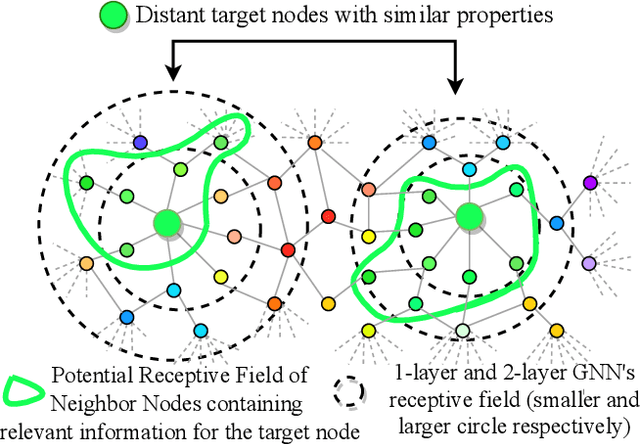


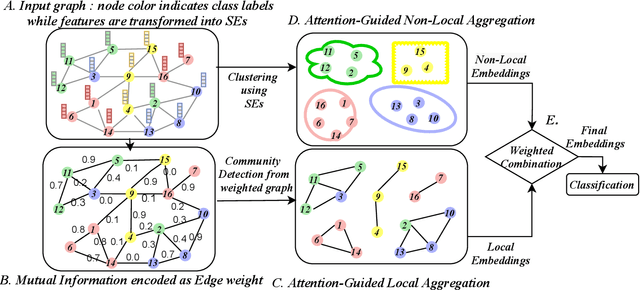
Abstract:Graph Neural Networks (GNNs) learn low dimensional representations of nodes by aggregating information from their neighborhood in graphs. However, traditional GNNs suffer from two fundamental shortcomings due to their local ($l$-hop neighborhood) aggregation scheme. First, not all nodes in the neighborhood carry relevant information for the target node. Since GNNs do not exclude noisy nodes in their neighborhood, irrelevant information gets aggregated, which reduces the quality of the representation. Second, traditional GNNs also fail to capture long-range non-local dependencies between nodes. To address these limitations, we exploit mutual information (MI) to define two types of neighborhood, 1) \textit{Local Neighborhood} where nodes are densely connected within a community and each node would share higher MI with its neighbors, and 2) \textit{Non-Local Neighborhood} where MI-based node clustering is introduced to assemble informative but graphically distant nodes in the same cluster. To generate node presentations, we combine the embeddings generated by bi-level aggregation - local aggregation to aggregate features from local neighborhoods to avoid noisy information and non-local aggregation to aggregate features from non-local neighborhoods. Furthermore, we leverage self-supervision learning to estimate MI with few labeled data. Finally, we show that our model significantly outperforms the state-of-the-art methods in a wide range of assortative and disassortative graphs.
Structure-Aware Hierarchical Graph Pooling using Information Bottleneck
Apr 27, 2021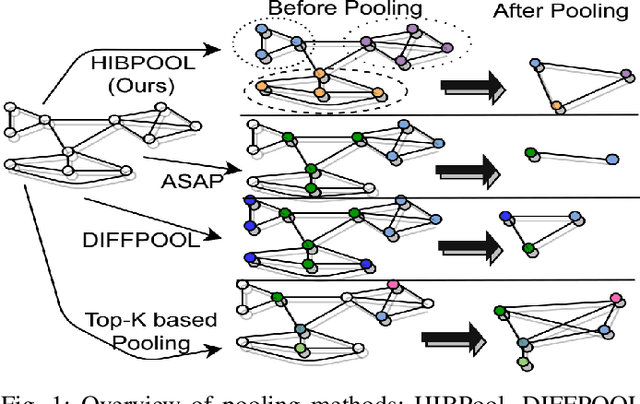



Abstract:Graph pooling is an essential ingredient of Graph Neural Networks (GNNs) in graph classification and regression tasks. For these tasks, different pooling strategies have been proposed to generate a graph-level representation by downsampling and summarizing nodes' features in a graph. However, most existing pooling methods are unable to capture distinguishable structural information effectively. Besides, they are prone to adversarial attacks. In this work, we propose a novel pooling method named as {HIBPool} where we leverage the Information Bottleneck (IB) principle that optimally balances the expressiveness and robustness of a model to learn representations of input data. Furthermore, we introduce a novel structure-aware Discriminative Pooling Readout ({DiP-Readout}) function to capture the informative local subgraph structures in the graph. Finally, our experimental results show that our model significantly outperforms other state-of-art methods on several graph classification benchmarks and more resilient to feature-perturbation attack than existing pooling methods.
SST-GNN: Simplified Spatio-temporal Traffic forecasting model using Graph Neural Network
Mar 31, 2021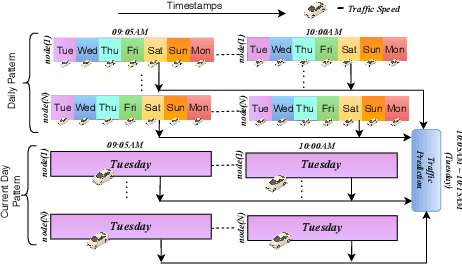
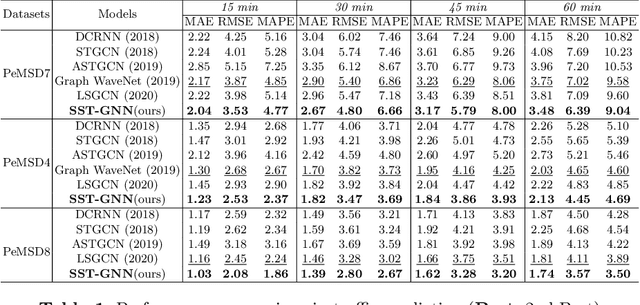
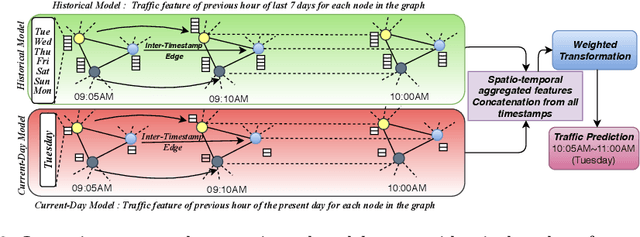

Abstract:To capture spatial relationships and temporal dynamics in traffic data, spatio-temporal models for traffic forecasting have drawn significant attention in recent years. Most of the recent works employed graph neural networks(GNN) with multiple layers to capture the spatial dependency. However, road junctions with different hop-distance can carry distinct traffic information which should be exploited separately but existing multi-layer GNNs are incompetent to discriminate between their impact. Again, to capture the temporal interrelationship, recurrent neural networks are common in state-of-the-art approaches that often fail to capture long-range dependencies. Furthermore, traffic data shows repeated patterns in a daily or weekly period which should be addressed explicitly. To address these limitations, we have designed a Simplified Spatio-temporal Traffic forecasting GNN(SST-GNN) that effectively encodes the spatial dependency by separately aggregating different neighborhood representations rather than with multiple layers and capture the temporal dependency with a simple yet effective weighted spatio-temporal aggregation mechanism. We capture the periodic traffic patterns by using a novel position encoding scheme with historical and current data in two different models. With extensive experimental analysis, we have shown that our model has significantly outperformed the state-of-the-art models on three real-world traffic datasets from the Performance Measurement System (PeMS).
 Add to Chrome
Add to Chrome Add to Firefox
Add to Firefox Add to Edge
Add to Edge